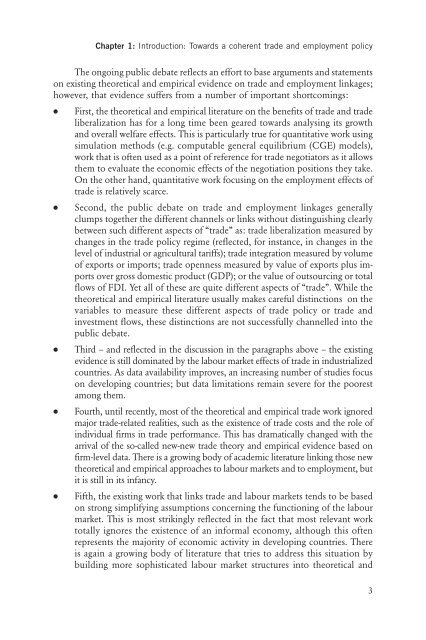Trade and Employment From Myths to Facts - International Labour ...
Trade and Employment From Myths to Facts - International Labour ...
Trade and Employment From Myths to Facts - International Labour ...
Create successful ePaper yourself
Turn your PDF publications into a flip-book with our unique Google optimized e-Paper software.
Chapter 1: Introduction: Towards a coherent trade <strong>and</strong> employment policy<br />
The ongoing public debate reflects an effort <strong>to</strong> base arguments <strong>and</strong> statements<br />
on existing theoretical <strong>and</strong> empirical evidence on trade <strong>and</strong> employment linkages;<br />
however, that evidence suffers from a number of important shortcomings:<br />
● First, the theoretical <strong>and</strong> empirical literature on the benefits of trade <strong>and</strong> trade<br />
liberalization has for a long time been geared <strong>to</strong>wards analysing its growth<br />
<strong>and</strong> overall welfare effects. This is particularly true for quantitative work using<br />
simulation methods (e.g. computable general equilibrium (CGE) models),<br />
work that is often used as a point of reference for trade negotia<strong>to</strong>rs as it allows<br />
them <strong>to</strong> evaluate the economic effects of the negotiation positions they take.<br />
On the other h<strong>and</strong>, quantitative work focusing on the employment effects of<br />
trade is relatively scarce.<br />
● Second, the public debate on trade <strong>and</strong> employment linkages generally<br />
clumps <strong>to</strong>gether the different channels or links without distinguishing clearly<br />
between such different aspects of “trade” as: trade liberalization measured by<br />
changes in the trade policy regime (reflected, for instance, in changes in the<br />
level of industrial or agricultural tariffs); trade integration measured by volume<br />
of exports or imports; trade openness measured by value of exports plus imports<br />
over gross domestic product (GDP); or the value of outsourcing or <strong>to</strong>tal<br />
flows of FDI. Yet all of these are quite different aspects of “trade”. While the<br />
theoretical <strong>and</strong> empirical literature usually makes careful distinctions on the<br />
variables <strong>to</strong> measure these different aspects of trade policy or trade <strong>and</strong><br />
investment flows, these distinctions are not successfully channelled in<strong>to</strong> the<br />
public debate.<br />
● Third – <strong>and</strong> reflected in the discussion in the paragraphs above – the existing<br />
evidence is still dominated by the labour market effects of trade in industrialized<br />
countries. As data availability improves, an increasing number of studies focus<br />
on developing countries; but data limitations remain severe for the poorest<br />
among them.<br />
● Fourth, until recently, most of the theoretical <strong>and</strong> empirical trade work ignored<br />
major trade-related realities, such as the existence of trade costs <strong>and</strong> the role of<br />
individual firms in trade performance. This has dramatically changed with the<br />
arrival of the so-called new-new trade theory <strong>and</strong> empirical evidence based on<br />
firm-level data. There is a growing body of academic literature linking those new<br />
theoretical <strong>and</strong> empirical approaches <strong>to</strong> labour markets <strong>and</strong> <strong>to</strong> employment, but<br />
it is still in its infancy.<br />
● Fifth, the existing work that links trade <strong>and</strong> labour markets tends <strong>to</strong> be based<br />
on strong simplifying assumptions concerning the functioning of the labour<br />
market. This is most strikingly reflected in the fact that most relevant work<br />
<strong>to</strong>tally ignores the existence of an informal economy, although this often<br />
represents the majority of economic activity in developing countries. There<br />
is again a growing body of literature that tries <strong>to</strong> address this situation by<br />
building more sophisticated labour market structures in<strong>to</strong> theoretical <strong>and</strong><br />
3

















